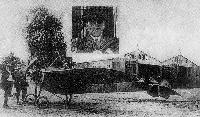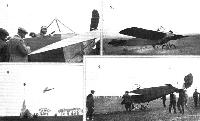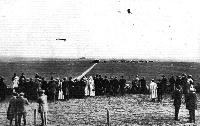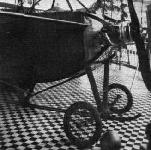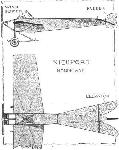А.Шепс Самолеты Первой мировой войны. Страны Антанты
После успешных полетов в 1909 году своего первого самолета Эдуард Ньюпор под впечатлением успешного полета Луи Блерио построил свой новый самолет "Ньюпор-II" - расчалочный фюзеляжный моноплан с двигателем "Даррак"(20л. с.). После ряда успешных полетов "двойки" Э. Ньюпор строит свой следующий самолет - "Ньюпор-II N" с двигателем собственной конструкции мощностью 27л. с. (двухцилиндровый, воздушного охлаждения). Самолеты стали выпускаться небольшими сериями с различными двигателями. Простые и дешевые машины быстро завоевали популярность. Их покупали не только во Франции и европейских странах, но и на американском континенте, и на Дальнем Востоке.
Модификации
"Ньюпор-II" - опытный моноплан с двигателем "Даррак" (20 л. с.).
"Ньюпор-II N" - отличался более мощным двигателем "Ньюпор" (27 л. с.) и конструкцией крыла большего размаха. Строился серийно.
"Ньюпор II G" - самолет серийный с ротативным двигателем "Гном" (50л. с.).
"Ньюпор II А" - с двигателем "Анзани" (40л. с.). Серийный.
"Ньюпор II В" - двухместный вариант с двигателем "Даррак" (30л. с.), отличался конструкцией кабины.
"Ньюпор III A" - двухместный вариант "Ньюпор II А", развитие серии.
Показать полностью
В.Шавров История конструкций самолетов в СССР до 1938 г.
"Ньюпор" учебный ("Ньюпор-II", "Ньюпор-Астра", "Ньюпор-III" ) по схеме и конструкции мало отличался от последующего широко известного "Ньюпора-IV", описанного ниже. Главная особенность их всех - фюзеляж необычно большого для 1911 г. миделя с глубокой посадкой летчика (кроме головы и плеч, полностью скрытого в фюзеляже), благодаря чему улучшилась аэродинамика самолета. Это впервые после А. Ф. Можайского проведенное мероприятие, да еще при монопланной схеме, и было секретом успеха этого самолета в 1911 г. До того, да и позже, летчик был или вообще открыт или же скрыт в фюзеляже лишь по пояс и сильно обдувался потоком.
В России применялись варианты учебных "Ньюпоров": "Ньюпор-Астра" с двигателями "Ньюпор" в 30 л. с., "Анзани" в 45 л. с. и "Гном" в 50 л. с., "Ньюпор-II" с двигателем "Анзани" в 25 л. с. и "Ньюпор" в 40 л. с., "Ньюпор-III" с двигателями "Анзани" в 25 л. с. и "Гном" в 50 л. с. Кроме того, на Московской воздухоплавательной выставке в 1912 г. был представлен "Ньюпор" с 4-цилиндровым рядным двигателем, не летавший. Соответственно колебались размеры и масса самолетов одноместных, двухместных и даже трехместных. "Ньюпор" учебный служил для этой цели недолго и быстро сменился военным типом "Ньюпор-IV", а для первоначального обучения в обиходе был "Фарман-IV" и другие самолеты.
Самолет|| опытный/ учебный/ учебный
Год выпуска||1911/1911/1911
Двигатель, марка||//
мощность, л.с.||28/30/50
Длина самолета, м||6,7/7,5/8
Размах крыла, м||8,1/8,4/9,8
Площадь крыла, м2||14/14/19
Масса пустого, кг||200/225/250
Масса топлива+ масла, кг||20/20+10/30+10
Масса полной нагрузки, кг||90/175/190
Полетная масса, кг||290/400/440
Удельная нагрузка на крыло, кг/м2||21/28/23
Удельная нагрузка на мощность, кг/лс||10/13,5/8,8
Весовая отдача,%||31/44/43
Скорость максимальная у земли, км/ч||120/109/110
Время набора высоты 1000 м, мин||20/25/12
Время набора высоты 2000 м, мин||?/?/40
Потолок практический, м||?/?/2300
Продолжительность полета, ч.||3/3/2,5
Показать полностью
J.Davilla, A.Soltan French Aircraft of the First World War (Flying Machines)
Societe Anonyme des Etablissements Nieuport
<...>
Nieport's second design was fitted with his two-cylinder 28-hp engine. This new aircraft was also a sleek monoplane and was tested at the laboratory of Gustav Eiffel. This second design was designated the Nieuport 2N and it flew on 5 January 1910. It was a single-seat monoplane with a conventional fuselage. It was constructed of four ash longerons braced with wooden beams attached by metal fasteners. The exterior of the fuselage was covered in fabric. The pilot was again seated low in the fuselage to minimize wind resistance. The tail surfaces had a semicircular shape and were attached directly to the fuselage. The undercarriage had a long skid extending between the wheels to act as a brake. It was spring loaded, and its narrow track often caused the Nieuport 2N to bounce along the airfield. The wings had a trapezoidal shape with rounded edges and were supported by two ash longerons. They were attached to the fuselage by steel tubes and braced with piano wire. There were multiple versions of the Nieuport 2N. On 10 June 1910 the Nieuport 2N, now fitted with a 30-hp Anzani engine, placed third at the 1911 speed trials at Reims. Edouard Nieport was killed in a plane crash that same year.
The next design, produced under the direction of Charles Nieport, who had assumed control of the company after his brother's death, was the Nieuport 3A, a two-seat version of the 2A.
<...>
Prewar Nieuport Aircraft
<...>
2. Nieuport 2N - 28 hp Nieuport designed engine.
3. Nieuport 2A - single-seater with a 40-hp Anzani engine.
4. Nieuport 2B - two-seater with a 20-hp Darracq engine.
5. Nieuport 2G - single-seaters with various Gnome rotary engines.
6. Nieuport 3A - same as Nieuport 2A but with two seats.
<...>
Показать полностью
L.Opdyke French Aeroplanes Before the Great War (Schiffer)
Deleted by request of (c)Schiffer Publishing
In 1910 he built another monoplane, this one with a full clean deep fuselage completely covered with fabric, the pilot sitting so low that only his head was exposed. The fuselage was built of wooden frames and longerons which were cable-braced (no piano-wire), its shape determined from tests with a piece of soap towed in the Seine behind a motorboat. A semicircular tailplane was fitted in front of a complicated tail consisting of a horizontal surface and 4 fixed small vertical surfaces, the whole thing swiveling to serve as both elevator and rudder.
The 2-spar thin tapered wings caused little drag: they were braced on each side by only 4 cables, 2 of which were used for warping. The undercarriage became a Nieuport trademark, made with a short central metal skid supported by 2 V-struts of metal. A wheel was fitted at each end of a leaf spring laid across the skid. On the ground the machine sat level, but waddled at take-off. The engine was a 28-32 hp air-cooled flat twin designed by Nieuport; at 1,200 rpm it was powerful enough and the aeroplane streamlined enough to provide a top speed of 80 kmh.
Before the end of 1910 the complex tail unit was altered, and with the semicircular tailplane, 2 small semicircular elevators, and the famous Nieuport rudder, it was used in slightly differing forms through 1917. A delta tailplane with 2 small elevators was tested, but not developed. The controls were a stick controlling the elevators and the rudder, and foot-pedals for wing-warping: Nieuport thought if the aeroplane tilted to the left, the pilot would naturally lean right, pushing the right-hand pedal to bring the machine level.
The little single-seater was known as the Nieuport II; it was to be developed into a variety of both land - and seaplanes, and provided the basis for the later 1915 Nieuport scouts and fighters. On 11 May 1911 Edouard Nieuport broke the world speed record at 119.7 kmh with only 28 hp. The next month he achieved 145 kmh with an 80 hp Gnome, and in 1913 he still held the world speed record with 2 passengers.
The successful Nieuport II was to be built in impressive numbers, and in several variants:
IIN: With the original Nieuport engine.
IIA: With the 40 hp Anzani.
IIB: A 2-seater with the 20 hp Darracq.
IIC: With Gnome engines of 50, 70, or 100 hp.
IIIA: This 2-seater was powered by a 40 hp Anzani.
Показать полностью
Jane's All The World Aircraft 1913
NIEUPORT. Etablissements Nieuport, 9 rue de Seine, Suresnes (Seine). Established 1910 by the late Edouard Nieuport. Approximate capacity of works: about 100 machines a year. Chief designer during 1911 was Pagny, who has now joined the Hanriot firm.
Model and date. II N. II G. IV G. 1912-13. IV M, 1912-13. 1913. 1913. 1913. 1913.
Monoplanes. 1912. 1912. 2-seater. 3-seater. 2-seater. 1-seater. 1-seater. Hydro 3-seater.
Length........ feet(m.) 23-2/3 (7.20) 23-2/3 (7.20) 25-2/3 (7.80) 25-2/3 (7.80) 26-1/4 (8) 21-3/4 (6.60) 23 (7) 29 (8.80)
Span ........ feet(m.) 28-1/3 (8.65) 28-1/3 (8.65) 36 (10.9) 39-1/3 (12.10) 36 (11) 28-1/3 (8.70) 27-2/3 (8.40) 40 (12.20)
Area ......sq.feet(m?.) ... ... ... ... 231 (21-1/2) 140 (13) 156 (14-1/2) 242 (22-1/2)
Weight, machine lbs. (kgs.) 529 (240) 683 (310) 771 (350) 1058 (480) 771 (350) 573 (260) 573 (260) 1230 (558)
Weight, useful lbs. (kgs.) ... ... ... ... ... ... ... ...
Motor ... ... ... h.p. 30 Nieuport Gnome Gnome Gnome Gnome 50 Gnome 30 Nieuport 100 Gnome
Speed, max. m.p.h. (km.) 75 (120) 87 (140) 72 (117) 72 (117) 69 (110) 78 (125) 69 (110) 72 (117)
Speed, min. m.p.h. (km.) ... 75 (120) 69 (110) ... ... ... ... ...
Number built during 1912... ... ... ... ... ... ... ... ...
Notes.--Early types had a Hanriot style landing carriage; the 1913 models revert to a Bleriot type. Warping wings. Fuselage entirely enclosed, rectilineal with rounded nose.
Показать полностью
Журнал Flight
Flight, July 16, 1910
NOVEL MACHINES AT RHEIMS.
BY HANDLEY PAGE.
<...>
Of the other monoplanes, the Werner, driven by Pischoff, and the Nieuport are distinct types of their own.
The Nieuport monoplane, with its rectangular-shaped, covered-in body, has the engine very neatly mounted in the "bows." The front of the body, about 2 ft. square, is finished quite flat and end-on to the wind, but the main spars are carried through and bent, so that the top and bottom ones on either side meet. The horizontal opposed two-cylinder motor used has a pressed steel ring fitting on each cylinder, and these rings fix on to the projecting ends of the main spars. The latter are bound round with tape to strengthen them. As in some of the Bleriots, there is a small inspection-door at the side of the body.
The "spring axle" arrangement has been adopted for the chassis. The body is carried in three steel tube V's with parallel tops, the parallel parts at the side of the body, the points of the V's being fixed to a long tubular skid below the body. The axle, made up of three "leaves," is about 5 ft. long, and carries at each end two wheels about 15 ins. in diameter. It is fixed in a small fitting at the bottom of one of the upright V tubes.
<...>
Flight, December 17, 1910
AEROPLANE SILHOUETTES FROM THE PARIS SHOW.
THE NIEUPORT MONOPLANE.
FRENCH-BUILT monoplane. Made its first appearance at the Rheims Meeting, 1910. Planes double - surfaced throughout. Entire fuselage is covered in with fabric. One of the lightest and most efficient aeroplanes on the market.
General dimensions. - Bearing surface, 14.9 metres; length overall, 7.50 metres; span, 8.40 metres.
Seating capacity. - One or two seats.
Engine. - 20-25-h.p. 2-cyl. horizontal opposed air-cooled Darracq motor. Normal revolutions, 1,200. The 5-cyl. 40-h.p. Anzani or the 50-h.p. Gnome can be fitted at an increased cost, as shown below.
Propeller. - Chauviere Integrate. Diameter, 2 metres. Pitch, 1.20 metres. Effective revs., 1,200.
Wheels and skids. - Two wheels connected by a flexible leaf spring. A single skid is placed centrally curving forwards and upwards.
Tail. - Non-lifting fin extending to elevator, which is in two parts to allow single rudder placed centrally to work freely.
Weight. - Complete with engine, 250 kilogs.
Lateral stability. - Maintained by flexing the trailing edges of the wings. The wings are connected by a patented arrangement by which one wing automatically alters the curvature of the other wing when under undue pressure, thereby maintaining stability to some degree.
Speed. - 75 kiloms. an hour.
System of control. - The flexing of the wings for the maintenance of lateral stability is performed by two independent pedals, each controlling owe wing. A wheel control actuates the rudder, and the backward and forward movement of a lever works the elevator.
Price. - Two-seater, with Darracq 20-h.p. motor, 18,000 francs. Two-seater, 40-h.p. 5-cyl. Anzani, 22,000 francs. One-seater, 50-h.p. Gnome, 24,000 francs. Two-seater, 50-h.p. Gnome, 26,000 francs. Any engine can be fitted if required.
Flight, June 8, 1912.
MODELS.
A Successful Scale Nieuport Model.
WE give this week illustrations and particulars of a type of model which we would like to see far more in evidence than it is - a type which one can really call a model as opposed to a "flying-stick." The model was designed and constructed by Mr. J. W. Burghope (Brighton and District Model Aero Club), it took three months to build, and is the result of over three years' experience, and the outcome of innumerable and miserable failures.
The model rises from the ground (hangar wood floor) after a run of 30 ft., and will then fly for 70 yards. Hand launched, 124 yards has been done combined with a duration of 14 secs., and an altitude of from 35 to 40 ft.
<...>
Показать полностью





